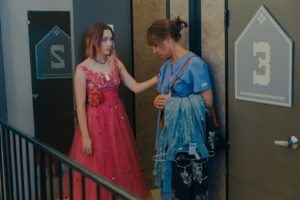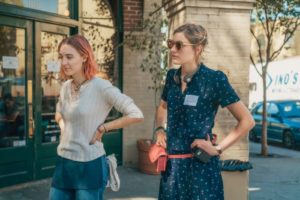 For her feature film directing debut, actress/writer Greta Gerwig tells a deeply personal coming-of-age story. Set in Sacramento, California during the early 2000’s, an artistic teen (Saoirse Ronan) remains in constant conflict with her opinionated mother (Laurie Metcalf).
For her feature film directing debut, actress/writer Greta Gerwig tells a deeply personal coming-of-age story. Set in Sacramento, California during the early 2000’s, an artistic teen (Saoirse Ronan) remains in constant conflict with her opinionated mother (Laurie Metcalf).
The process of co-writing two films with writer/director Noah Baumbach was an important step for Gerwig in finding her own voice as the screenwriter of Lady Bird. When the script was finished, she felt it was her time to direct; she was ready to “go for it.”
“I wanted to write something about home and how home is something that only makes sense when you are leaving. I wanted the mother-daughter story to be the most vivid part at the center of it,” shared Gerwig. “I don’t really decide what I’m writing beforehand, because for me the process of writing is discovery. I don’t have a beginning, middle and end all figured out. I have a hunch, then start writing and listening to these characters as I start building them. They tell me who they are. It’s inspiration that you’re not completely sure where it comes from.” As an actor working on multiple films, Gerwig had the opportunity to watch other directors work with their crews while developing an understanding of the detailed collaborative effort by the various crafts.
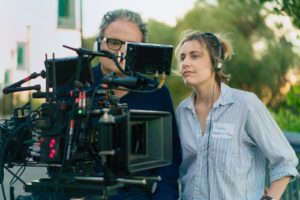 Once the script was written, and very early on in the process, Gerwig engaged cinematographer Sam Levy. Having worked with Levy on several films, she loved him as an artist and felt he was the type of person she could spend every day with. They spent almost a year talking, looking at photographs and paintings, and shot listing the whole movie several times. “Like me, he likes to over prepare so we can be open to things that are spontaneously arising on set,” explained Gerwig. “We really had this groundwork of a common language and a shared idea of what it would look like.” Levy And Gerwig knew they wanted the photography to have a very strong and consistent point of view in the way they set-up the shots and the lenses they used. They described the look as “plain and lush.”
Once the script was written, and very early on in the process, Gerwig engaged cinematographer Sam Levy. Having worked with Levy on several films, she loved him as an artist and felt he was the type of person she could spend every day with. They spent almost a year talking, looking at photographs and paintings, and shot listing the whole movie several times. “Like me, he likes to over prepare so we can be open to things that are spontaneously arising on set,” explained Gerwig. “We really had this groundwork of a common language and a shared idea of what it would look like.” Levy And Gerwig knew they wanted the photography to have a very strong and consistent point of view in the way they set-up the shots and the lenses they used. They described the look as “plain and lush.”
Production designer Chris Jones worked with Gerwig on 20th Century Women. He had done a wonderful job on the film “capturing that time and that place,” which was the type of detailed work she was looking for on her own film. April Napier, the costume designer, was recommended to her. Both had to create a period in the not too distant past that was authentic and stylized with the feeling of memory.
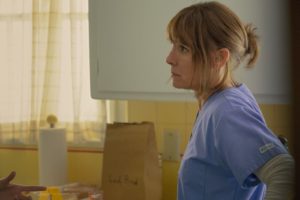 The director felt it was important to gather her key crew as early as possible, so she could start talking to them and they could build their teams. As an indie film, Gerwig admitted that the budget was not lavish, but “part of the creativity was figuring out how to do the film within certain parameters. They were all exceptionally good at that.”
The director felt it was important to gather her key crew as early as possible, so she could start talking to them and they could build their teams. As an indie film, Gerwig admitted that the budget was not lavish, but “part of the creativity was figuring out how to do the film within certain parameters. They were all exceptionally good at that.”
During post production for Frances Ha and Mistress America, Gerwig spent a lot of time in the editing room watching the process up close with Baumbach and his editor, Jennifer Lame. When Gerwig needed an editor for Lady Bird, Lame suggested Nick Houy. Gerwig knew right away that Houy was perfect, because of the way he talked about the script. He knew what the story was trying to do, understanding it “in his DNA.” “It’s an intimate process, because it really is the two of you working together for so long. Editing is you and this other person in the foxhole,” commented Gerwig. “The saying is: you write a movie three times: once when you write it; once when you shoot it; once when you edit it.”
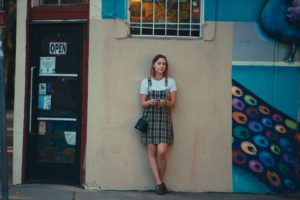 Gerwig did not deviate from the script through improvisation. The footage shot was on the page. At the same time, the editing redefined the rhythms in the script. Although the editor assembled the film during production, in order to make sure all the necessary elements for each scene had been shot, Gerwig disliked watching an assembly, preferring to be in the room as the film was edited, so she could figure out the cut together with her editor.
Gerwig did not deviate from the script through improvisation. The footage shot was on the page. At the same time, the editing redefined the rhythms in the script. Although the editor assembled the film during production, in order to make sure all the necessary elements for each scene had been shot, Gerwig disliked watching an assembly, preferring to be in the room as the film was edited, so she could figure out the cut together with her editor.
“Once you watch a scene all the way through, you can never un-see it that way. I like to start the editing process with everything on the table, building it brick by brick,” Gerwig confessed. “If I don’t know how it is put together, I don’t know how to fix it. Obviously, it’s a long, painstaking process, but there is always that moment when it is kind of working and you feel it’s together. It’s thrilling.”
Spending so much time with an edit can cause a loss of perspective. Gerwig noted that everything by the end of the week looked bad, but she had to keep working. She would finesse scenes or moments without watching the whole film, reminding herself she was dealing with something “that was not perfect yet.” To keep her viewing fresh, Gerwig liked looking at the edit all the way through first thing on Monday morning, after a whole weekend of not seeing the cut.
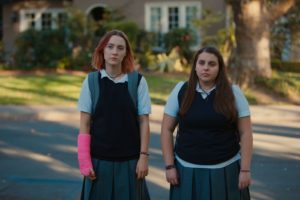 Another way for Gerwig to judge how the story was working was to avoid watching the whole film until she could screen it for a new person. She could then see and feel it from that new viewpoint. She never had a big test audience. The largest screening before the Telluride Film Festival was sixty people. The director found it very helpful to play the film for two or three people at a time. Drawing from a mix of filmmakers who gave very precise notes, and people she trusted, such as a friend who was a lawyer, another who was a nurse and yet another who was a book editor, provided the feedback she needed to fine tune the story. “The kind of mix of people who knew how the sausage was made, and people who didn’t,” was perfect for her purpose. “That was an important thing for me, sitting with someone else watching it for the first time. You can have a vicarious experience of the film. I am very sensitive to other people, so when I started showing people cuts, just even sitting with them I could sense it.”
Another way for Gerwig to judge how the story was working was to avoid watching the whole film until she could screen it for a new person. She could then see and feel it from that new viewpoint. She never had a big test audience. The largest screening before the Telluride Film Festival was sixty people. The director found it very helpful to play the film for two or three people at a time. Drawing from a mix of filmmakers who gave very precise notes, and people she trusted, such as a friend who was a lawyer, another who was a nurse and yet another who was a book editor, provided the feedback she needed to fine tune the story. “The kind of mix of people who knew how the sausage was made, and people who didn’t,” was perfect for her purpose. “That was an important thing for me, sitting with someone else watching it for the first time. You can have a vicarious experience of the film. I am very sensitive to other people, so when I started showing people cuts, just even sitting with them I could sense it.”
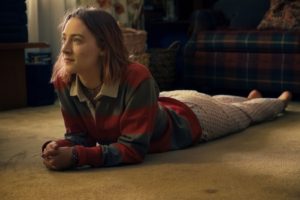 Gerwig deeply believes that everyone who works on a movie is a storyteller, whether they are a production assistant, sound mixer, grip or an actor. She wanted each person to feel they were connected to the story and that they were all part of the family making the movie.
Gerwig deeply believes that everyone who works on a movie is a storyteller, whether they are a production assistant, sound mixer, grip or an actor. She wanted each person to feel they were connected to the story and that they were all part of the family making the movie.
Something Gerwig took from director Mike Mills was to have every person on set wear name tags. Although she got to know her crew very well being with them all the time, often actors are brought onto the set at the last minute when everything is all lit and ready to go. They don’t get to know everyone, especially if they are only on the movie for a couple of days. This way, everyone has a name and “a real presence.”
For Gerwig, the collaborative experience of numerous people contributing their talents to bring her words and vision to the screen makes filmmaking a highly gratifying art form.